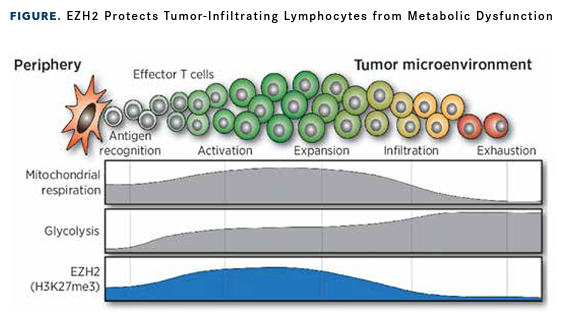Publication
Article
Oncology Live®
Molecular Approaches May Increase Responsiveness to Immunotherapy for Patients With Metastatic Melanoma
Author(s):
The recent development of therapeutics which stimulate immune response to tumor cells has revolutionized the treatment landscape for cutaneous melanoma.
Alan J. Tackett, PhD

Cutaneous melanoma is the deadliest form of skin cancer with incidence rates increasing each year. Historically, treatment options for patients with metastatic melanoma have been limited, and 5-year survival rates were less than 10% for patients with advanced-stage disease.
However, the recent development of therapeutics which stimulate immune response to tumor cells has revolutionized the treatment landscape for this disease. But although some patients experience a durable response to these treatments, others receive little benefit or develop resistance after initially exhibiting a positive response. For example, immune checkpoint inhibitors (ICIs) have shown encouraging, albeit limited, success for the treatment of metastatic melanoma. ICIs are monoclonal antibodies developed to inhibit targets including CTLA-4, with agents such as ipilimumab (Yervoy), and PD-1, with agents including pembrolizumab (Keytruda) and nivolumab (Opdivo). These agents interact with the immune system to maintain homeostasis and prevent autoimmunity.
Alan J. Tackett, PhD, deputy director of Winthrop P. Rockefeller Cancer Institute at the University of Arkansas for Medical Sciences in Little Rock, is leveraging state-of-theart technological approaches to discover why some patients respond better to ICI therapy compared with others. The longterm goal of this analysis is to determine whether druggable molecular pathways can be identified among nonresponders to ICI and therapeutics designed to increase responsiveness and potentially save lives.
Finiding ICI Roadblocks in Melanoma
Recent efforts by our group have shown that melanoma progression is correlated with a disordered epigenetic program. These perturbations can negatively affect response to ICI therapy.1-3
Cell growth is regulated by diverse mechanisms, including epigenetic control of access to the genetic code through dynamic condensation or decondensation of chromatin.1 This equilibrium is mediated by posttranslational modification (PTM) of the histone proteins which compose the protein core around which DNA strands are coiled. Perturbations in the pattern of histone PTMs can result in loss of cellular identity and cancer progression.1
Nathan Avaritt, PhD

To better understand epigenetic dysregulation in melanoma, we performed a quantitative proteomic analysis of histone PTMs in melanoma cell culture as well as patient tumors. We found that histone H3 at lysine 27 (H3K27me3) levels positively correlate with epithelial-mesenchymal transition (EMT) and aggressiveness in melanoma cell lines and in patient melanoma tumors. Additionally, transcriptionally repressive PTM is enriched at the promoters of tumor suppressor genes in metastatic melanoma relative to primary tumors and melanocytes.1
Moreover, inhibition of H3K27 methyltransferase EZH2 (EZH2i) reduces H3K27 methylation, promotes epithelial morphology, reduces proliferation, suppresses invasion, and promotes transcription and expression of tumor suppressor genes in vivo. These findings were recapitulated in archival patient tissues.1
To link these patterns of epigenetic program malfunction to ICI response, we performed a quantitative proteomic analysis on treatment-naïve metastatic melanoma tumors. Results from our analysis showed that tumors that are nonresponsive to ICI therapy are characterized by elevated H3K27me3 and decreased E-cadherin expression.2
Further proteomic profiling between responding and nonresponding tumors revealed differences which centered on mesenchymal transition as judged by decreased E-cadherin and other protein and epigenetic features in nonresponding tumors. In particular, E-cadherin transcript and protein levels strongly correlate with survival outcomes in patients treated with checkpoint inhibitors.2 These data provide supporting evidence for combining EZH2i with ICI therapy to improve responsiveness in patients with metastatic melanoma.
Our results revealed for the first time that aggressive melanoma tumor cells depend on elevated H3K27me3 levels, and that this altered epigenetic program may be associated with resistance to ICI therapy. However, it is recognized that T cells depend on EZH2 activity during tumor infiltration, evidence which contradicts the use of EZH2i in combination with ICI therapy. We found that EZH2 inhibition induces T-cell exhaustion and dysfunction in the melanoma tumor microenvironment.
Using a multi-omics approach, we identified mitochondrial dysfunction as a driver of EZH2inhibition induced T-cell exhaustion. This loss of EZH2 function leads to metabolic exhaustion in CD8-positive T cells (FIGURE). We assessed whether reprogramming T cells with the gain-offunction EZH2 Y641F mutation that is not affected by EZHi would enhance their ability to control tumor growth in vivo. Results from our analysis showed that CD8-positive T cells expressing the EZH2 Y641F mutation were superior at killing tumor cells and significantly inhibited tumor growth in vivo.3

These findings were consistent with EZH2 playing a protective role for tumor-infiltrating lymphocytes in the stress-inducing melanoma tumor microenvironment. Further, the findings suggest that therapeutic interventions combining ICI with EZH2 inhibition must account for the opposing effects of decreased H3K27me3 in tumor cells and immune cells infiltrating the melanoma tumor microenvironment.
Our results indicate that response to ICI therapy is highly influenced by an altered epigenetic program which promotes EMT though the silencing of tumor suppressor genes in melanoma. Although these data provide evidence that combining ICI therapy with EZH2i could overcome ICI resistance in some patients, the treatment must be fine-tuned because of T-cell reliance on EZH2 activity during activation and immune response.
In the study by Koss et al, we engineered tumor-specific T cells to express the gain-of-function EZH2 Y641F mutation. This alteration enhanced the control of tumor growth, demonstrating that these findings may also allow advancement of cellular therapies against melanoma tumors.3
References
- Sengupta D, Byrum SD, Avaritt NL, et al. Quantitative histone mass spectrometry identifies elevated histone H3 lysine 27 (Lys27) trimethylation in melanoma. Mol Cell Proteomics. 2016;15(3):765775. doi:10.1074/mcp.M115.053363
- Shields BD, Mahmoud F, Taylor EM, et al. Indicators of responsiveness to immune checkpoint inhibitors. Sci Rep. 2017;7(1):807. doi:10.1038/s41598-017-01000-2
- Koss B, Shields BD, Taylor EM, et al. Epigenetic control of Cdkn2a.Arf protects tumor-infiltrating lymphocytes from metabolic exhaustion. Cancer Res. 2020;80(21):4707-4719. doi:10.1158/0008-5472. CAN-20-0524










